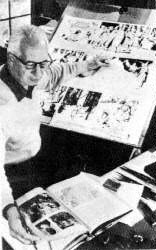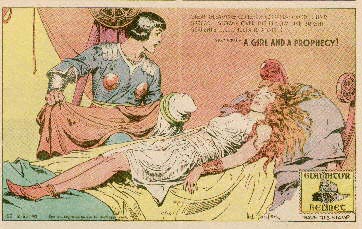

Harold R. Foster was born in Halifax, Nova Scotia on August 18, 1892. At 18 he earned money as a prize fighter and later he prospected for gold. He discovered a lode but had it taken away from him by a band of thieves, after which he abandoned the job. He rode a bicycle 1000 miles from Winnipeg, Manitoba to Chicago in 1921 to enroll in the Chicago Art Institute, later doing additional studies at the National Academy of Design & the Chicago Academy of Fine Arts.
He became an illustrator in the middle twenties doing magazine illustration as well as advertising posters. Some of his work at theis time appeared on the covers of Popular Mechanics.
While in Chicago, Foster also became an assistant to J. Allen St.John, one of the top illustrators of the time. St.John was the artist whose work was most closely associated with Edgar Rice Burrough's "Tarzan", and in 1928 when Joseph Neebe acquired the rights to produce a Tarzan comic strip, he went to St.John's studio to persuade him to draw the strip. St.John refused, but Neebe reportedly spotted Foster, who he had previously worked with and signed him to illustrate only the first episode in the first few months of 1929 at which point he went back to advertising illustration.

It is interesting to note that the first Tarzan daily strip appeared on the same day that Dick Calkin's first Buck Rogers daily strip appeared, January 7, 1929.
However, the Neebe office was not altogether happy with Foster's replacement (Rex Maxon) and in 1931 lured Foster back to draw the newly syndicated Sunday page Tarzan beginning in September 1931.
Foster's "Tarzan" was one of the most beautifully drawn strips and became an immediate smash. Foster's artistic style was copied by many at the time. But in 1936 he began to tire of illustrating the droll scripts he had to work with and his fertile imagination began to swirl with new ideas, so in February 1937 his "Prince Valiant" premiered.
He was far enough ahead with his Tarzan pages that his last Tarzan did not appear until May 1, eleven weeks after Prince Valiant began to appear in the same papers.

Prince Valiant, along with Alex Raymond's "Flash Gordon" were the premier adventure strips of their time and these two artists are responsible for inspiring generations of artists including Lou Fine, Frank Frazetta, Al Williamson, Wayne Boring (who assisted Foster from 1966-69) and Mark Shultz among scores of others. His Prince Valiant is revered in the annals of comic art and his originals are highly prized works of art.
His virtuosity with pen and brush techniques made each page an amazing conglomeration of lines. His dry brush style was an inspiration to the young Alex Raymond before the first Flash Gordon page was a spark in Raymond's imagination. Foster's use of dialogue also took on a unique form. His text was not to explain the story as much as to compliment the artistic visuals. It is konown that Foster took some sixty hours weekly to produce each Sunday episode (there was never a daily), and he never included a local that he had not personally visited for thematic accuracy.
In 1971 he drew his last Prince Valiant Sunday page, handing over the artistic chores to John Cullen Murphy. He had illustrated 1789 Prince Valiant pages. He made appearances at many comic book conventions and was a fan favorite for years. He died in 1981.
A panel from a 1940 Prince Valiant
Sunday page. 287k Jpeg.
A panel from a 1940 Prince Valiant
Sunday page. 300k Jpeg.
Hal Foster in his studio, 90k Jpeg